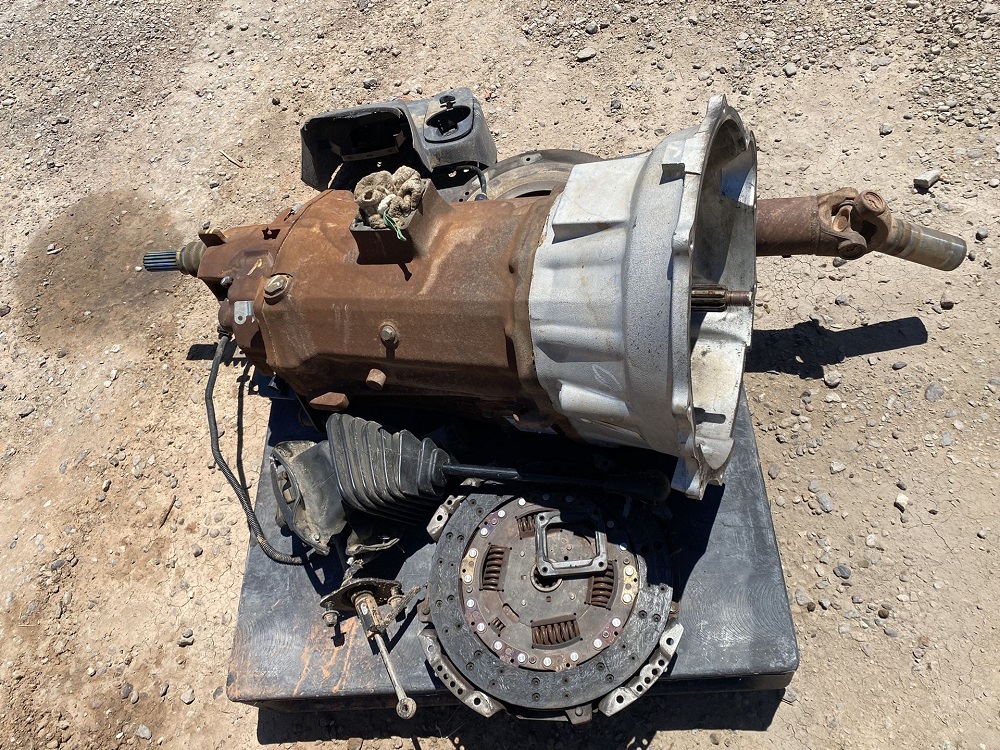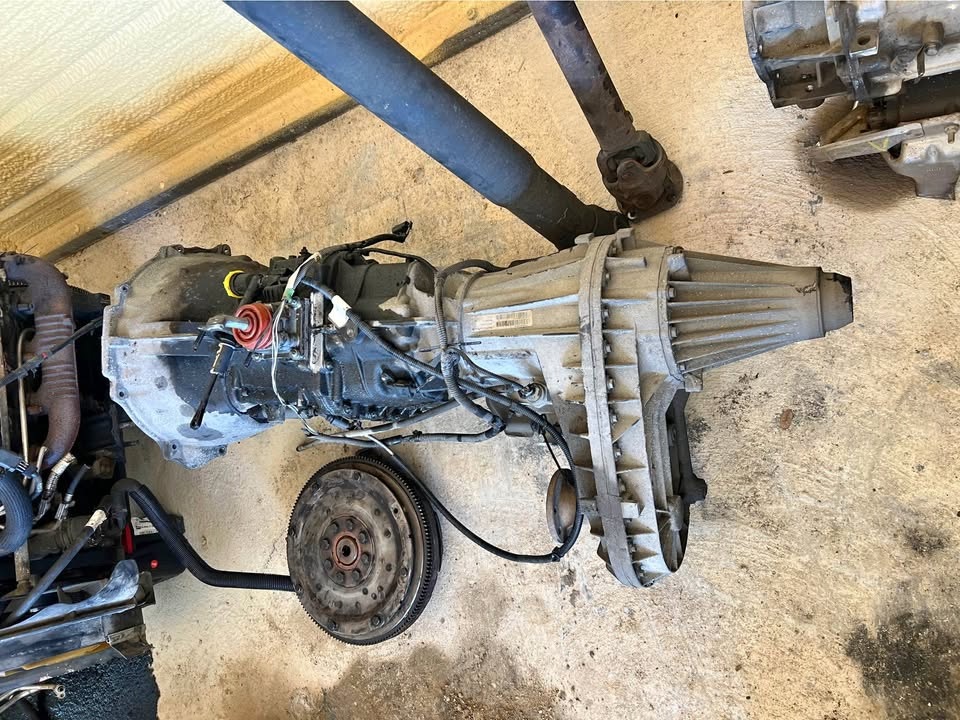The NV5600 and G56 are both six-speed manual transmissions commonly paired with heavy-duty Dodge/Ram trucks, especially those equipped with powerful Cummins engines.
Built to handle the rigors of towing, hauling, and commercial use, these transmissions differ in their materials, gear ratios, and driving characteristics.
Whether you need the raw strength of the NV5600 or the refined drivability of the G56, this guide dives into their key features, trade-offs, and performance to help you make the best choice for your needs.

1. Basic Background and Fitment
NV5600
The NV5600, produced by New Venture Gear, was a workhorse transmission featured in Dodge Rams from the late 1990s to mid-2000s.
Known for its durability, this cast-iron six-speed was designed to handle the torque demands of powerful diesel engines. With a torque capacity of 550+ lb-ft, it was a favorite for towing enthusiasts and commercial users.
However, its hefty build led to its eventual phase-out around 2005 in favor of the G56, which promised a lighter design and smoother operation.
G56
Introduced in 2005, the G56 was developed by Mercedes’ subsidiary Getrag. Its aluminum casing made it lighter than its predecessor, reducing overall truck weight and contributing to fuel efficiency.
While capable of managing factory torque levels, the G56 was engineered for better drivability and less effortful shifting.
Its lighter construction, however, has raised questions among heavy-duty users about its long-term durability under extreme conditions.
2. Gear Ratios and Drivability
NV5600
The NV5600 offers a robust gear ratio spread, starting with a low first gear around 5.63:1 and finishing with a single overdrive at approximately 0.73:1. This setup provides excellent crawling power, making it ideal for towing heavy loads or off-road maneuvers.
However, the wide gaps between gears can sometimes leave mid-range driving feeling less precise, as the engine might not always stay in the optimal RPM range.
Shifting with the NV5600 is deliberate and weighty. While this inspires confidence in high-torque scenarios, the notchy engagement can be cumbersome, particularly during city driving or stop-and-go traffic.
Cold mornings might exacerbate the stiffness, requiring the transmission to warm up before shifting becomes smoother.
G56
The G56 features a slightly deeper first gear, approximately 6.29:1, and an overdrive ratio of around 0.74:1. In theoretical capabilities, it is similar to the NV5600 but with closer spacing between gears.
This design allows smoother transitions and keeps the engine in a more consistent RPM range, which is particularly useful for highway cruising and lighter towing applications.
Its shifting characteristics lean more toward a lighter, car-like feel. This provides a welcome break from the heavier NV5600 shifts, making the G56 more comfortable for daily use.
However, under heavy towing or high-stress situations, some drivers report that the lighter construction translates to increased gear noise or a less “solid” engagement.

3. Construction and Durability
NV5600
The NV5600’s robust construction begins with its cast-iron main case, designed to handle high torque loads without flexing.
This design ensures structural integrity under extreme conditions, such as towing heavy trailers or operating in rugged environments.
However, this strength comes with added bulk—the NV5600 is significantly heavier than its counterpart, which can slightly affect fuel efficiency and make installation or removal more challenging.
Internally, the NV5600 boasts sturdy gears, synchros, and bearings, which, when properly maintained, provide reliable performance. Still, the transmission isn’t without vulnerabilities.
Overheating is a known issue, particularly under prolonged heavy loads. Regular fluid changes with high-quality synthetic gear oil and installing auxiliary coolers can help mitigate these concerns.
Also, the transmission’s sheer size makes repairs or replacements more labor-intensive and expensive, particularly as OEM parts become harder to source.
G56
The G56 features an aluminum housing, making it noticeably lighter than the NV5600. This reduction in weight aids vehicle efficiency and simplifies installation, but it also introduces potential durability concerns under extreme torque demands.
Some users report that the aluminum case flexes slightly under high stress, leading to issues like gear rollover noise or premature wear in heavy-duty applications.
Internally, the G56 is well-suited for factory torque levels, though it has less overhead capacity for performance upgrades compared to the NV5600.
High-horsepower builds often require reinforcing components such as steel or bronze shift forks and upgraded bearings.
These modifications can address concerns about long-term durability in modified trucks but add extra cost to the transmission’s upkeep.
4. Maintenance and Fluid Requirements
NV5600
The NV5600’s maintenance needs reflect its heavy-duty design. With a fluid capacity of around 5–6 quarts, it requires high-quality synthetic gear oil to maintain optimal lubrication and prevent overheating.
This transmission’s cast-iron case retains heat longer, making fluid changes after extensive use more challenging. Proper fluid levels are essential, as insufficient lubrication can accelerate bearing wear or cause gears to overheat.
Maintenance costs can be higher for the NV5600 due to the limited availability of some OEM parts. While aftermarket solutions exist, rebuilds for this transmission often require specialized expertise and equipment.
Also, owners towing heavy loads or pushing the transmission beyond factory specs frequently install auxiliary coolers to combat overheating and extend component life.
G56
The G56, with its aluminum case, has a lighter fluid requirement and generally calls for thinner synthetic manual transmission fluid. This fluid ensures smoother shifts, particularly in colder climates.
However, under heavy towing or extreme conditions, the aluminum case tends to heat up more quickly. Many owners choose upgraded fluids or install cooling systems to address issues like gear whine and heat-induced wear.
Rebuilding the G56 is often simpler due to its more modern design, but parts availability can vary. Some OEM components are limited in supply, though aftermarket manufacturers and international sources (thanks to the transmission’s Mercedes origins) help fill gaps.
Regular fluid checks and timely replacements are crucial to maintaining the G56’s longevity, particularly for trucks used in demanding environments.
5. Real-World Performance
NV5600
The NV5600 is a favorite among drivers who prioritize durability and strength in extreme conditions. Known for its robust cast-iron build, it excels in high-torque applications, such as towing heavy trailers or hauling massive loads.
Its gear ratios, particularly the deep first gear, offer excellent control during slow-speed maneuvers, making it reliable for off-road and commercial use.
However, the NV5600’s rugged design comes with trade-offs. It can feel heavy and less refined during daily driving, especially in city traffic.
Shifting requires more deliberate effort, and the transmission’s weight can contribute to a truck’s overall bulk, impacting fuel efficiency slightly.
Despite these drawbacks, its reliability under pressure makes it a go-to choice for truck owners pushing their vehicles to their limits.
G56
The G56 stands out for its lighter design and smoother operation, offering a more refined driving experience. The aluminum housing and closer gear ratios make it well-suited for daily driving and highway use. Shifting feels more fluid compared to the NV5600, reducing fatigue during long trips or urban commutes.
That said, the G56 does show its limits under extreme conditions. Some drivers report gear rollover noise or slight flexing when towing heavy loads, especially with high-output engines or performance modifications.
While adequate for most factory applications, the G56 might require upgrades, like steel shift forks or better bearings, to handle significant power increases reliably.
6. Cost and Overall Value
NV5600
The NV5600 commands a premium in the used and rebuilt market due to its reputation for strength and durability. Its cast-iron construction and ability to handle high torque loads make it a valuable option for owners who push their trucks to the limit.
However, the scarcity of parts, especially OEM replacements, can drive up costs for repairs or rebuilds. This transmission is best suited for drivers who need maximum reliability for heavy towing or off-road demands and are willing to invest in maintenance.
G56
The G56 typically comes at a lower upfront cost compared to the NV5600, especially when sourced used. Its lighter design and smoother operation cater to a broader range of truck owners, from daily drivers to moderate-duty towers.
While it may lack the extreme durability of the NV5600, the G56 offers a balance of affordability and practicality. Aftermarket upgrades are often sufficient to address weaker points, such as gear noise or wear under high loads, making it a versatile choice for most applications.
Final Thoughts
Choosing between the NV5600 and G56 comes down to your specific needs. If your truck frequently handles extreme towing or off-road challenges, the NV5600’s robust cast-iron construction and high torque capacity provide unmatched reliability. However, its heavier build and higher cost may not suit every driver.
On the other hand, the G56 offers a lighter, smoother, and more modern driving experience, making it ideal for everyday use and moderate towing.
While it may require upgrades for heavy-duty applications, its affordability and easier handling make it a practical choice for most owners.
Both transmissions excel in their own way—your decision depends on how and where you plan to use your truck.
Was This Article Helpful?
Thanks for your feedback!
Rami Hasan is the founder of CherishYourCar.com, where he combines his web publishing experience with a passion for the automotive world. He’s committed to creating clear, practical guides that help drivers take better care of their vehicles and get more out of every mile.



